The Ukrainian War Update for Oct. 11, 2024--genocide and brutality have become the norm...
Here at The Corners, whether in the short-lived magazine format or on the blog, we (and now Yours Truly) have had no qualms about calling the Russian "special operation" genocide from the start.
Yes, there were times when this was deemed premature (although the massacre in Bucha, the shelling of apartments, schools, essential kidnapping of children--thousands of whom were sent to Belarus bizarrely in tandem with the Red Cross there--and the rape of women girls and prisoners should have long ended that debate), but in truth this has been obvious from the start. But lest there somehow be doubts, Russian State Duma Deputy Gen. Andrey Viktorovich Gurulyov made this point clearly on Russian television stating that the end result of the Russian invasion will be Ukraine that has been destroyed and emptied of population.
To put it more accurately, Gurulyov attempted to ease doubts over the war by saying the Russian war of attrition will simply wear down the Ukrainians who will soon have "nothing left." All that will be left will be "old people, and not even all of them."
No, that's not Putin speaking, and no that is not an official statement of the Russian government, but we've seen what we've seen--and we've heard what we've heard.
If you want to listen yourself, here is a Linkedin link to the horse's mouth, courtesy of poster Marijn Markus, one of many who has endlessly lobbied to gain the attention and support of the West:
https://www.linkedin.com/feed/update/urn:li:activity:7249332464530157568/?originTrackingId=r1gnQUXgTzutBM3kPXQ7OA%3D%3D
But now for other news, while my post two weeks ago did focus on finding various silver linings, Russia simply keeps upping the pressure, and although Russia is also stretched when it comes to equipment and men, it keeps finding bodies to throw into meat waves that follow heavier and heavier glide bombs. The strategy is brutal, unforgiving, but it is undeniably putting Ukraine under tremendous strain.
And no, Putin has not called for a full mobilization (although he did call for mobilizing another 180,000 men in mid-September, as noted in the past update--which brought fighting troop levels up to 1.5 mln men--so call it what you will). This means that the Russian army is still creaking forward, slowly gaining ground, despite obscene brutality against its own troops and the use of decades old (or sometimes older) and antiquated equipment.
The next line is predictable. The West dithers. Yet that is not altogether true. Europe is picking up the pace (and the slack, considering an apparent lack of US will and the uncertainty of the coming elections) with arms deliveries, and most recently the French promised Mirage 2000 fighters with advanced systems by early 2025. Yet a blunt resignation also appears to be settling in even among hawks. On the one hand, stories of GRU killings (and bombings, such as in arms depots in the Czech Republic and Bulgaria) while once somehow brushed aside or even treated as psuedo news (keep in mind that only in April of this year did the Czech government "confirm" that GRU was behind 2014 ammunition warehouse bombings in 2014 in Vrbetice) are finally being recognized as proof that Russia has never stopped waging war on the West.
On the other hand, even mega hawk (and artillery ammunition conjurer of magical proportions) Czech Prime Minister Gen. Petr Pavel has stated that Ukraine will have to face the reality that it is unlikely to retake land lost in Donbas and Donetsk.
And no, it does not appear that the the US Joe Biden administration (of which Vice President and presidential candidate Kamala Harris does still play a part) is willing to allow long-range strikes with US missiles--strikes that are vital for Ukraine to prosecute the war. The Ukrainians are upping their own game here, hitting oil and ammunition depots to dramatic effect. And while much was made of the Ukrainian taking of the gas transit hub at Sudzha during the Kursk counteroffensive, Ukraine's reminder that it will not renew an oil transit agreement that has up until now allowed Russian oil to reach Hungary, Slovakia and the Czech Republic is a game changer. Especially for Slovakia and Hungary at any rate. But in fact... not only. A number of fuel traders have been quietly acquiring Russian oil and gas and sending this to EU countries throughout the war and despite high level talk of sanctions--as much has simply not been sanctioned (for example, sanctions on Russian LPG will kick in at the beginning of next year).
So there are little wins--or difficulties, depending on where you stand--but for Ukraine the coming winter will be exceptionally harsh. The coming muddy season--which probably will really begin in early November--will certainly hamper enemy advances, but Russian determination (a la Gurulyov) to wipe out infrastructure and freeze Ukrainians will be ugly indeed.
Which means that the time is now for the West to finally come through in timely fashion with weapons and supplies. And to be brave.
Although we apparently are no longer any good at that.
And now for the roundup.
The big picture...
I haven't put one of these in recently, but the wider Deepstate UA map, which now always must include not only Kharkiv but Sumy (with a few blue and red arrows thrown in a la Yours Truly) would seem to do much to display what is no "military operation" but an all-out, widespread war on Ukraine. (See below.)
As this is already a long blog post, we'll allow the maps to do most of the talking, working down from Kursk, but with the focus primarily on the Kupiansk to Pokrovsk line and slightly south, as here are the predominant worries of the week.
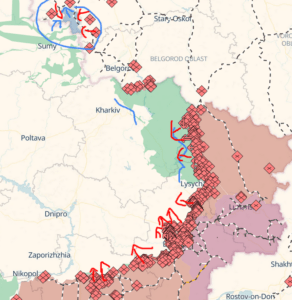
Kharkiv and Kursk...
First, while this will not be a deep dive, let's be clear that the goal is not to minimize the importance of the Kharkiv front and defense. Back in the early summer--when it became clear that Russia would reignite an offensive at Kharkiv--there was a sense of panic. Defense lines were said to be primitive and unfinished, and Russia had once again built up a massive meat brigade that promised real trouble.
At that time, however, sources for The Corners said unequivocally that the Russians would make no progress here and Kharkhiv could not be taken. Hindsight is 20-20, but now as we hit mid-October it is clear these sources were correct. In fact, this episode of the war should be considered a Ukrainian victory.
This is not to say that the fighting has not been brutal. At Vovchansk, especially, battles have seen streets of ruins change hands repeatedly, including, as we understand it, this very week, and even as I write this, there are reports that a factory, the Vovchansk Aggregate Production Site has been won and lost and is now back in Russian hands. Likewise, there are reports that Russian mechanized units are intensely active at this front (and here is a prayer that the rains come early this year). Here, however, we do not expect a breakthrough or immediate high-risk situation akin to Kupiansk, Svatove or Pokrovsk. That said, Russian glide bomb activity has increased to decimating effect.
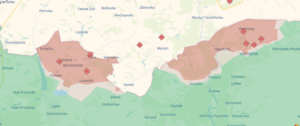
Now for Kursk. Much has changed over the past weeks--apart from the apparent Ukrainian strategy to come up with still more creative counters in the face of stiffening Russian resistance and the true beginning of meat-waves at this front. But first, a comparison of maps.
Below is the Kursk map from Sept. 16. Notice the lack of clarity at Snagost, as well as the Ukrainian counter toward Glushkovo, which appeared to have the goal of trapping Russian forces at Snagost and potentially garnering another round of prisoners for future negotiations.
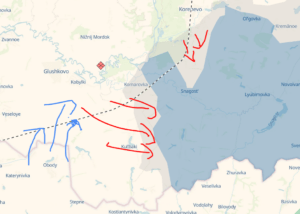
That was an overly optimistic scenario. First, while further south the rains still have not come, the muddy season has begun in Kursk, and this will hamper both sides. That said, it will likely hurt further lightning strikes by Ukraine in what has been a sector of movement. Second, Deepstate UA mapping tends to drag behind, especially where Ukrainians are on the offensive, but it is clear that Ukraine has a tremendous task to keep offensive momentum while still holding ground. It has not managed to do this at Snagost, which can be seen clearly below. Interesting is a pocket of Russian holdouts at Kremanoe, but the Russian punch into Novoivanovka now threatens the entire Ukrainian northern salient.
This is a recent development (this is a screenshot of a Deepstate map from Oct. 11.).
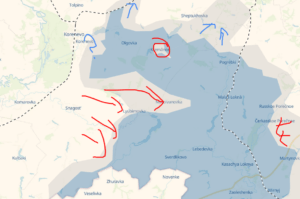
Yet only days before the drive to Novoivanovka was not seen. Below is a map from Oct. 9.
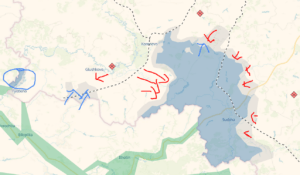
That said, at this point the situation is so extremely fluid on the ground that a prediction is folly. Further north, Ukrainian forces are attacking and reportedly making ground, and free Russian forces and Ukrainian troops are rumored to be restarting strikes toward Glushkovo. Additionally, those very Russian forces driving toward Novoivanovka could very well drive too deep and wind up cut off.
So as for the Novoivanovka drive, well, no, it's not good news, but this one is worth monitoring closely.
Kupiansk...
What is undeniably bad news is what appears to be Russian success at Kupiansk all the way down beyond Pokrovsk. Much of this is meat-grinder stuff, but forced Ukrainian pullouts are keeping Yours Truly up at night, and over the past two to three days... stress levels are high.
First, as a review, below is the Kupiansk-Borova-Sloviansk-Kramatorsk-Pokrovsk supply line that we have been talking about for well more than a year.
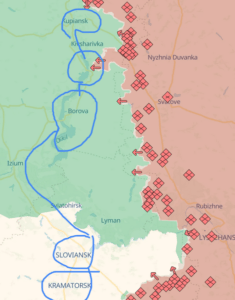
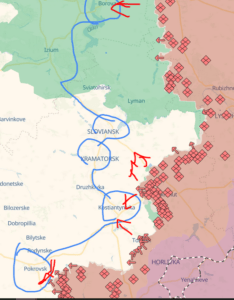
Now back to Kupiansk. Also for well more than a year, I've noted that despite buildups (with a major buildup weakened by a need for Russia to move elite forces away from Kupiansk-Svatove to the Zaporizhzhia front in the summer), Kupiansk and even the tiny village of Synkivka has held firm.
This was the case even a few days ago, as can be seen by this map from Oct. 9.
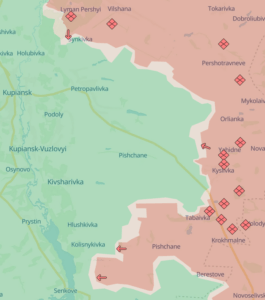
This has changed. Below is a close up of Synkivka, with added arrows to represent what we believe are actual Russian gains, with fierce fighting taking place in the forest near Holubivka. This does not mean that Kupiansk is already in immediate danger, but it does represent a sudden (and unexpected) Russian advance. However, a theoretical factor here does not bode well for Ukraine--this being that supply lines at the Oskil/Pischane junction further south (more on that in a moment) are disrupted, as are even supply lines from the crucial Pokrovsk hub much further south at the beginning of the chain.
In fact, while some may scoff at the Pokrovsk theory, there is little doubt that the Pischane-Oskil junction is now under tremendous pressure, with Russian forces right on top of Kruhliakyvka/Senkove/Kolisnikyvka, likely rendering what was believed to be a key supply line now inoperable.
(Note in the second map that the red Russian arrow toward Borova does not indicate current movement, but it highlights a long perceived Russian goal of taking that hub, although this is likely moot now that the Oskil/Pischane drive has proven horribly effective).
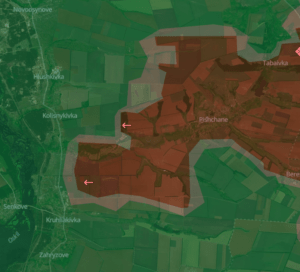
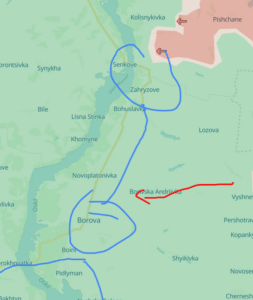
Further south, Russian forces have intensified attacks at Bilohorivka and Horyhorivka. Noteworthy is that even further south Ukraine has stunted Russian efforts at Chasiv Yar (formerly known as the Bakhmut front in Donetsk), and fighting south of Bakhmut at Klischiivka and Andriivka is remarkably still vicious and ongoing, but the Ukrainians have held.
Pokrovsk and beyond...
Now Pokrovsk. As mentioned in the "silver lining" article, Pokrovsk has remarkably held firm. This is not to say that supply lines from Pokrovks further north have not been disrupted, but this blunting of Russian goals is a victory of sorts.
That said, the Russian war machine is no longer the laggard it was only last year (and this may be due to a purge in the top ranks that has allowed younger Russian officers to have more influence). There is intense fighting north east at Toretsk, with Russian forces slowly gainging ground. At Pokrovsk, defenses have been effective to the point of being suicidal, but this has resulted in Russian forces have turning south, with the cauldron at Hirnyk possibly meaning a Ukrainian pullout will be necessary there. Likewise, pressure north and south of the Kurakhove waterway (the Ovcha) means trouble.
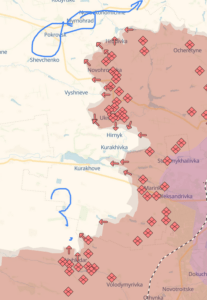
First, however a closer shot of Pokrovsk. Russian forces are inching toward Mynohrad after possibly having taken Mykolaivka, but the good news is that this is still slow going. If forced to make a prediction here, The Corners sources would state that Pokrovks will be a hub too far--as long as the rains do come soon and hard in November.
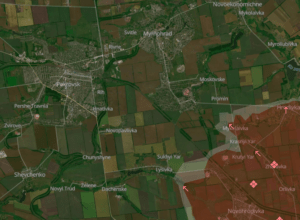
Hirnyk--low on the ensuing map--is another story.
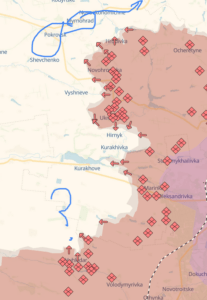
As note above, a cauldron has long been forming at Hirnyk, but this has likely been complicated by the fall of Vulhedar to the south, which, in truth, evokes a sense of dread. Leaks from Ukrainian troops at Hirnyk have left little doubt that they know their situation is desperate, but crucial. That said, the fall of Vulheldar, which in once sense is not necessarily strategically important, likely does have propaganda implications. On one hand, there is practically nothing left of that city. On the other hand... there is nothing left of that city, which falls right back into what is clearly a genocidal invasion.
Yet in the immediate future, Ukrainian forces at Hirnyk are at risk. If Russian bloggers are to believed (and in this case, they may well be), Russians troops are narrowing the exit by pushing hard from the north and south and there is true danger of encirclement here.
In short, the Ukrainian general staff will likely need to make hard choices north and south of the Ovcha. It it will need to make these choices quickly.
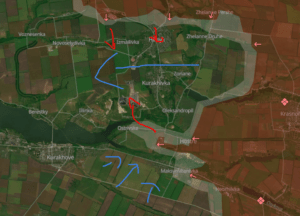
Further south...
There is little to report in Zaporizhzhia and Kherson, although there are signs of renewed Russian efforts in the latter.
Which means that for today's blog, it's over and out.
Slava Ukrainii and God bless. There is nothing more to say.
Preston Smith is a licensed investigator based in Gdansk, Poland. He can be reached at query@cddi.pl.
Maps courtesy of Deep State UA.
File photo of the wreckage following a missile strike on Pokrovsk in June, courtesy of Dsns.gov.ua, CC BY 4.0 <https://creativecommons.org/licenses/by/4.0>, via Wikimedia Commons.



Lon
9 miesięcy agoExcellent well written post! As always you get to the point like no other.
Preston Smith
8 miesięcy agoMuch obliged!
Hope you keep reading!
Preston